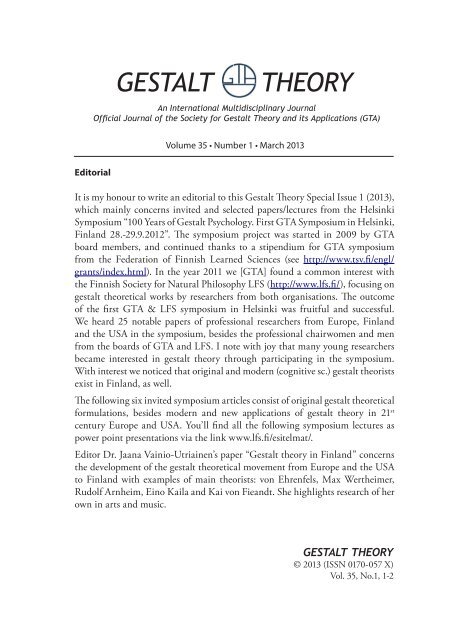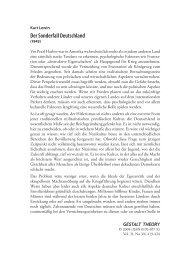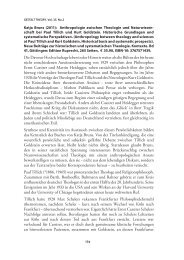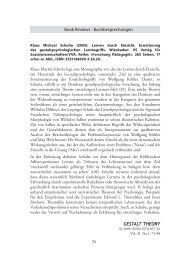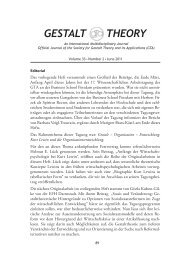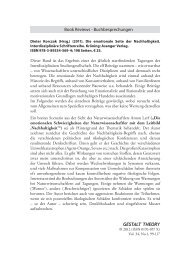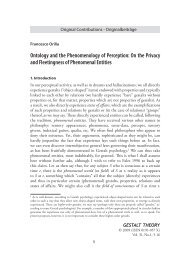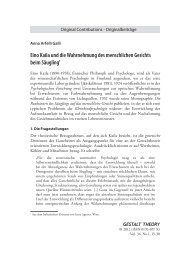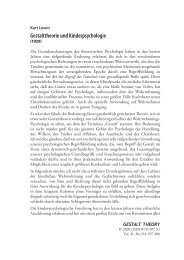GESTALT THEORY
GESTALT THEORY
GESTALT THEORY
Create successful ePaper yourself
Turn your PDF publications into a flip-book with our unique Google optimized e-Paper software.
<strong>GESTALT</strong><br />
<strong>THEORY</strong><br />
An International Multidisciplinary Journal<br />
Official Journal of the Society for Gestalt Theory and its Applications (GTA)<br />
Volume 35 • Number 1 • March 2013<br />
Editorial<br />
It is my honour to write an editorial to this Gestalt Theory Special Issue 1 (2013),<br />
which mainly concerns invited and selected papers/lectures from the Helsinki<br />
Symposium “100 Years of Gestalt Psychology. First GTA Symposium in Helsinki,<br />
Finland 28.-29.9.2012”. The symposium project was started in 2009 by GTA<br />
board members, and continued thanks to a stipendium for GTA symposium<br />
from the Federation of Finnish Learned Sciences (see http://www.tsv.fi/engl/<br />
grants/index.html). In the year 2011 we [GTA] found a common interest with<br />
the Finnish Society for Natural Philosophy LFS (http://www.lfs.fi/), focusing on<br />
gestalt theoretical works by researchers from both organisations. The outcome<br />
of the first GTA & LFS symposium in Helsinki was fruitful and successful.<br />
We heard 25 notable papers of professional researchers from Europe, Finland<br />
and the USA in the symposium, besides the professional chairwomen and men<br />
from the boards of GTA and LFS. I note with joy that many young researchers<br />
became interested in gestalt theory through participating in the symposium.<br />
With interest we noticed that original and modern (cognitive sc.) gestalt theorists<br />
exist in Finland, as well.<br />
The following six invited symposium articles consist of original gestalt theoretical<br />
formulations, besides modern and new applications of gestalt theory in 21 st<br />
century Europe and USA. You’ll find all the following symposium lectures as<br />
power point presentations via the link www.lfs.fi/esitelmat/.<br />
Editor Dr. Jaana Vainio-Utriainen’s paper “Gestalt theory in Finland” concerns<br />
the development of the gestalt theoretical movement from Europe and the USA<br />
to Finland with examples of main theorists: von Ehrenfels, Max Wertheimer,<br />
Rudolf Arnheim, Eino Kaila and Kai von Fieandt. She highlights research of her<br />
own in arts and music.<br />
<strong>GESTALT</strong> <strong>THEORY</strong><br />
© 2013 (ISSN 0170-057 X)<br />
Vol. 35, No.1, 1-2
<strong>GESTALT</strong> <strong>THEORY</strong>, Vol. 35, No.1<br />
The Finnish psychologist Dr. Manu Jääskeläinen highlights in his paper<br />
“Personality as a Dynamic Gestalt System. A Study of a Book on Personality<br />
Psychology by Eino Kaila” the first Finnish gestalt theoretical oriented psychologist<br />
Kaila’s book and some of his main articles. Jääskeläinen’s paper consists of clear<br />
examples and critics of Kaila’s main theoretical contributions. In particular he<br />
describes to the reader how Kaila was impressed by Gestalt psychology and its<br />
originators Wertheimer, Koffka and Köhler, becoming one of the main gestalt<br />
oriented theorists since 1920. Kaila’s work still has an effect in 21 st century<br />
curriculum studies in Helsinki University in Philosophy and Psychology.<br />
Professor Dr. Herbert Fitzek from the BSP Berlin Potsdam, a board member<br />
of the GTA, contributes his paper “Artcoaching. Gestalt Theory in Arts and<br />
Culture”. Artcoaching according to Fitzek is a modern movement of gestalt<br />
theory in arts and culture, which is “coming from the use of art reception as<br />
a tool for intensifying individual and group dynamics and dealing with the<br />
strengthened efficacy of Gestalt in extended reception processes”. Fitzek clarifies<br />
the field of artcoaching with phenomenological analysis experiments.<br />
Dr. Marianne Soff from Pädagogische Hochschule Karlsruhe gives us an<br />
interesting gestalt theoretical case study, “Gestalt Theory in the Field of Educational<br />
Psychology: An example”, which she has applied with young students of teacher<br />
education. She highlights in her paper how theories of Metzger and Lewin are<br />
applied and evaluated in her summer course, with an interesting structure and<br />
seven progressive exercises. This kind of experiment would be useful in different<br />
fields of gestalt theoretical application in teaching and lectures. Soff mentions that<br />
gestalt theory belongs [mainly] to the past, to which she introduces new and fresh<br />
ideas applicable to teachers’ education in the future.<br />
Finnish prof. Emer. of didactical physics Dr. Kaarle Kurki-Suonio highlights<br />
his pioneer work - teaching physics to teachers - over three decades in Helsinki<br />
University. His paper “Concepts as Gestalts in Physics Teacher Education” reveals,<br />
with clear demonstrations and descriptions of his important work, how to develop<br />
teaching in physics to suit teachers of students at different levels. Gestalt theory<br />
works as a basis for his scientific thinking, besides his practical experiments.<br />
Dr. Tuomo Suntola in his paper “Gestalting Structures in Physics” gives the<br />
reader a historical overview of developments in philosophy (intuitive) and physics<br />
(empirist/logical) from Thales, Aristotle and Ptolemy to the modern thinkers,<br />
via the Middle Ages to the 21 st century. His paper is based on his own research<br />
and publications since 2002. We are given multiple views of the main thinkers<br />
and theoretical developments over 2500 years. Suntola’s figures complement his<br />
ideas and his descriptions of historical-theoretical structure.<br />
Jaana Vainio-Utriainen<br />
2


